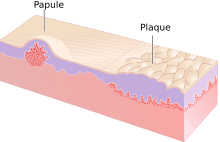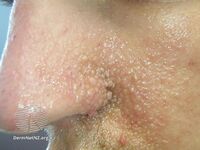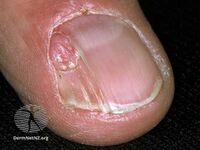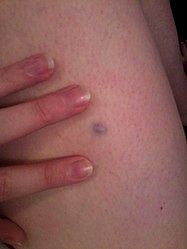Papule
| Papule | |
|---|---|
 | |
| Fibrous papule of the nose | |
| Pronunciation | |
| Specialty | Dermatology[2] |
| Symptoms | Small, well-defined bump in skin[2] |
A papule is a small, well-defined bump in the skin.[2] It may have a rounded, pointed or flat top, and may have a dip.[2] It can appear with a stalk, be thread-like or look warty.[3] It can be felt; and may be soft or firm and its surface may be rough or smooth.[4] Some have crusts, erosions, or scales.[5] A papule can be flesh colored, yellow, white, brown, red, blue or purplish.[6] There may be just one or many, and they may occur irregularly in different parts of the body or appear in clusters.[2] It does not contain fluid but may progress to a pustule or vesicle.[2] A papule is smaller than a nodule; it can be as tiny as a pinhead and is typically less than 1 cm in width, according to some sources,[2][3] and 0.5 cm according to others.[6] If filled with blood vessels it is termed a small hemangioma.[7]
Its color might indicate its cause, such as white in milia, red in eczema, yellowish in xanthoma and black in melanoma.[2] They may open when scratched and become infected and crusty.[8] It can be distinguished from a macule by feeling it.[5]
Definition

A papule is a small, well-defined bump in the skin.[2] It is smaller than a nodule; it can be as tiny as a pinhead and is typically less than 1 cm in width, according to some sources,[2][3] and 0.5 cm according to others.[6]
Signs and symptoms
A papule may have a rounded, pointed or flat top, and may have a dip.[2] It can be polygonal but is never rectangular or square.[9] It can appear with a stalk, be thread-like or look warty.[3] Ulceration, oozing, bleeding or thin blood vessels may be present in a papule.[9] It can be soft or firm and its surface may be rough or smooth.[2] Some have crusts or scales.[2] A papule can be flesh colored, yellow, white, brown, black, blue or purplish, or varying shades of red.[6][9] The intensity of redness might indicate how long the papule has been present.[9] There may be just one or many, and they may occur irregularly in different parts of the body or appear in clusters.[2] It does not contain fluid but may progress to a pustule or vesicle.[2]
-
Angiofibromas in tuberous sclerosis
-
Periungal angiofibroma associated with tuberous sclerosis
-
Pearly penile papules
-
Comedo
-
Blue nevus
Differential diagnosis
Angiofibromas are papules, types of which include the usually solitary fibrous papule of the nose and periungual angiofibroma, and multiple in pearly penile papules, and the facial angiofibromas as may be seen in tuberous sclerosis.[10] Other conditions presenting with papules include condyloma acuminatum, squamous papilloma, basal cell carcinoma and parulis.[11]
Papules with scale on the palms and soles may occur in secondary syphilis, psoriasis, eczema, tinea manuum, mycosis fungoides.[9] In lichen planus papules may be itchy, flat-topped, polygonal, purplish with white streaks, and can be solitary, or occur in clusters or in a line.[9]
See also
References
- ↑ "Papule definition and meaning - Collins English Dictionary". Archived from the original on 2021-04-29. Retrieved 2021-09-19.
- ↑ 2.00 2.01 2.02 2.03 2.04 2.05 2.06 2.07 2.08 2.09 2.10 2.11 2.12 2.13 2.14 James, William D.; Elston, Dirk; Treat, James R.; Rosenbach, Misha A.; Neuhaus, Isaac (2020). "2. Cutaneous signs and diagnosis". Andrews' Diseases of the Skin: Clinical Dermatology (13th ed.). Elsevier. p. 11. ISBN 978-0-323-54753-6.
- ↑ 3.0 3.1 3.2 3.3 Oakley, Amanda. "Terminology in dermatology". dermnetnz.org. Archived from the original on 5 August 2016. Retrieved 20 September 2021.
- ↑ "Description of Skin Lesions - Dermatologic Disorders". MSD Manual Professional Edition. Archived from the original on 15 April 2022. Retrieved 14 August 2022.
- ↑ 5.0 5.1 Bolognia, Jean L.; Schaffer, Julie V.; Duncan, Karynne O.; Ko, Christine (2022). "1. Basics". Dermatology Essentials (2nd ed.). Elsevier. pp. 4–5. ISBN 978-0-323-70971-2. Archived from the original on 2024-01-03. Retrieved 2024-02-12.
- ↑ 6.0 6.1 6.2 6.3 Dinulos, James G. H. (2019). "1. Principles of diagnosis and anatomy". Habif' Clinical Dermatology (7th ed.). Elsevier. p. 4. ISBN 978-0-323-61269-2. Archived from the original on 2023-05-21. Retrieved 2023-07-06.
- ↑ Morris-Jones, Rachael (2019). "1. Introduction". In Morris-Jones, Rachael (ed.). ABC of Dermatology (7th ed.). Hoboken: Wiley Blackwell. p. 3. ISBN 978-1-119-48899-6. Archived from the original on 2023-02-09. Retrieved 2023-07-06.
- ↑ "papule" at Dorland's Medical Dictionary
- ↑ 9.0 9.1 9.2 9.3 9.4 9.5 Allen, Herbert B. (2010). "1. Papulosquamous diseases". Dermatology Terminology. Philadelphia: Springer. pp. 1–13. ISBN 978-1-84882-839-1. Archived from the original on 2023-07-01. Retrieved 2023-07-06.
- ↑ Paller, Amy S.; Mancini, Anthony J. (2020). "9. Cutaneous tumors and tumor syndromes". Clinical Pediatric Dermatology: A Textbook of Skin Disorders of Childhood and Adolescence (6th ed.). St Louis, Missouri: Elsevier. p. 251. ISBN 978-0-323-54988-2. Archived from the original on 2021-09-25. Retrieved 2021-10-18.
- ↑ Langlais, Robert P.; Miller, Craig S.; Gehrig, Jill S. (2017). "18. Diagnostic and descritive terminology: macule, patch, erosion, ulcer". Color Atlas of Common Oral Diseases, Enhanced Edition (5th ed.). Burlington: Jones & Bartlett Learning. p. 22. ISBN 978-1-284-24098-6. Archived from the original on 2023-07-02. Retrieved 2023-07-06.




